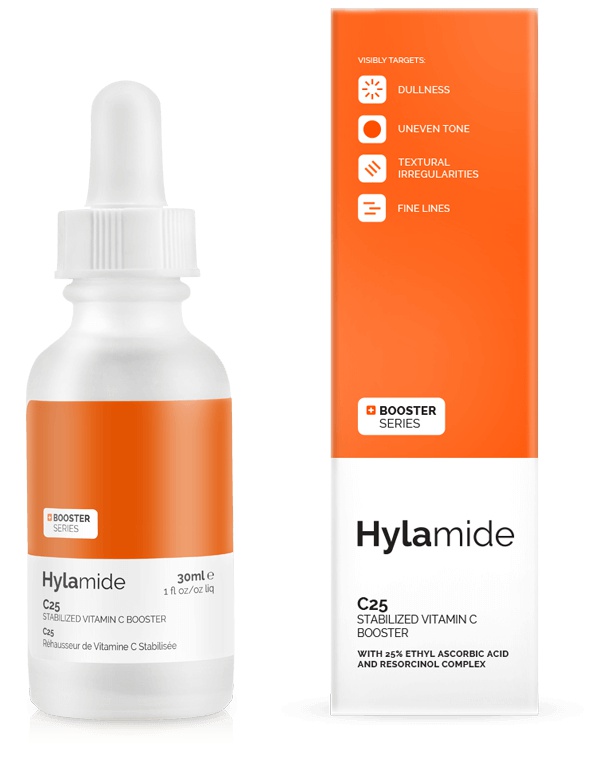
Booster;C25
Highlights
Skim through
| Ingredient name | what-it-does | irr., com. | ID-Rating |
|---|---|---|---|
| Ethoxydiglycol | solvent, moisturizer/humectant, perfuming | 0, 0 | |
| Ethyl Ascorbic Acid | antioxidant, skin brightening | goodie | |
| Hydroxyphenoxy Propionic Acid | skin brightening | goodie | |
| Phenylethyl Resorcinol | antioxidant, skin brightening | goodie |
Hylamide Booster;C25Ingredients explained
A nice odorless liquid used mainly as a superior solubilizer and efficacy booster for cosmetic active ingredients such as skincare bigshot vitamin C, self-tanning active DHA or the anti-acne gold standard, benzoyl peroxide.
Other than that it can also be used in hair care products where it gives a longer-lasting and more uniform coloring. According to a manufacturer, it might even prevent the formation of split ends.
A very stable and promising form of the skincare superstar, Vitamin C. If you do not know why Vitamin C is such a big deal in skin care, you can catch up here. In short, Vitamin C has three proven magic abilities: antioxidant, collagen booster, and skin brightener. The problem, though, is that it's very unstable, turns brown and becomes ineffective in no time (after a few month) and the cosmetics industry is trying to come up with smart derivatives that are stable and have the magic properties of pure Vitamin C.
Ethyl Ascorbic Acid or EAC for short is an "etherified derivative of ascorbic acid" that consists of vitamin C and an ethyl group bound to the third carbon position. This makes Vitamin C very stable and soluble in both water and oil.
A skin-brightening, spot fading active ingredient that goes by the trade name Radianskin. The in-vitro (made in the lab) test results of the manufacturer show that it can prevent melanin formation more effectively than other well-known skin-lightening agents, like ascorbyl glucoside, kojic acid, or arbutin and it has equivalent efficacy to skin-lightening gold-standard ingredient hydroquinone but without cytotoxicity.
There is also a L'Oreal sponsored research showing that the combination of hydroxyphenoxy propionic acid, ellagic acid, yeast extract, and salicylic acid produced comparable skin-lightening results as the standard prescription combination of 4% hydroquinone cream and 0.025% tretinoin cream after 12 weeks.
A skin-lightening and antioxidant active ingredient derived from a molecule that exists naturally in Pine tree. According to the clinical results of the manufacturer, 0.5% of phenylethyl resorcinol is more effective than 1% of well-known skin-lightener kojic acid.
Though the results from the manufacturer sound quite promising, a skin-lightening study from 2013 involving phenylethyl resorcinol shows quite moderate results. In the 80 participants, 12-week study, phenylethyl resorcinol was combined with three other actives (disodium glycerophosphate, L-leucine, and undecylenoyl phenylalanine) and only 57% of the participants showed at least a moderate response and 17% did not improve at all.
You may also want to take a look at...
| what‑it‑does | solvent | moisturizer/humectant | perfuming |
| irritancy, com. | 0, 0 |
| what‑it‑does | antioxidant | skin brightening |
| what‑it‑does | skin brightening |
| what‑it‑does | antioxidant | skin brightening |





